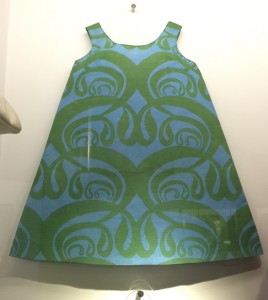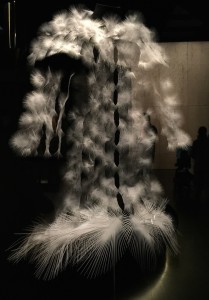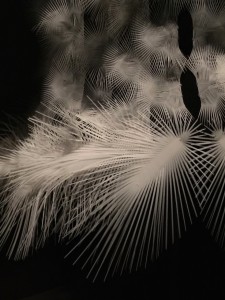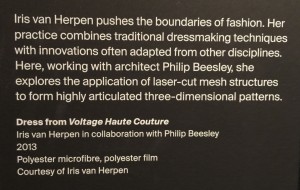In your own words, write a definition of ‘textiles’ in its broadest sense. What materials do you consider to be ‘textile’ materials? When is a material not a textile? Can you identify any examples?
The first thing I think of is the wealth of fabrics available to be used for clothing, furnishings, structures such as tents and sails. There are many ways to create a fabric. I’ve just been side tracked into creating a mind map and as well as the obvious plant/animal/petro-chemical based fabrics,traditionally made by weaving, knitting, felting, tanning; we need to consider new technologies such as laminating techniques, laser cutting and 3D printing.
This is part of the Creating Luxury exhibition at the V&A, it perfectly showcases new technology and interestingly uses plastic as a luxury fibre.
 This paper dress by Dispro (Meyersohn and Silverstein Ltd) 1967 demonstrates how textile design has always been at the forefront of technology, materials often developed for space, exploration or military use, then filtered down into the mainstream.
This paper dress by Dispro (Meyersohn and Silverstein Ltd) 1967 demonstrates how textile design has always been at the forefront of technology, materials often developed for space, exploration or military use, then filtered down into the mainstream.This was an early use of Tyvec type material, celebrated as the potential future of fashion, perhaps the first concept of throw away society.
Textiles have always had medical uses, from sinew stitches, through bandages, to heart valves, perhaps not immediately considered textiles but my thoughts have led me to consider for a moment that as textile techniques are used in the process , then things are textile products.
I have not yet written a definition.
“Textiles are objects made from or with materials that are in some way flexible.”
I’ve tried to elaborate but objects then get ruled out e.g manufactured seems to rule out the precious work of spiders, Kevlar body armour would seem to fit into textile category, as would chain mail. Bike helmets use fibreglass which is certainly a fibre, not flexible as an end product though. Very confusing .
‘Textiles’ is difficult to define. The study of textiles may cause us to follow many threads or spin our own. What a fascinating journey.
My computer dictionary says this ; A textile[1] or cloth[2] is a flexible woven material consisting of a network of natural or artificial fibers often referred to as thread or yarn. Yarn is produced by spinning raw fibres of wool, flax, cotton, or other material to produce long strands.[3] Textiles are formed by weaving, knitting, crocheting, knotting, or pressing fibres together (felt).The words fabric and cloth are used in textile assembly trades (such as tailoring and dressmaking) as synonyms for textile. However, there are subtle differences in these terms in specialized usage. Textile refers to any material made of interlacing fibres. Fabric refers to any material made through weaving, knitting, spreading, crocheting, or bonding that may be used in production of further goods (garments, etc.). Cloth may be used synonymously with fabric but often refers to a finished piece of fabric used for a specific purpose (e.g., table cloth).
In what ways could textiles have stories or narratives attached to them? There is a lot you could think about here, both in terms of the story of or behind the textile and the story potentially told by the textile. Try to give some examples.
Clothing is … an exercise of memory… It makes me explore the past… how I feel when I wore that…(Louise Bourgeois)
www.moma.org/explore/collection/lb/themes/fabric_works
The Louise Bourgeois quote resonates within me. Personal items of clothing hold memories more than photographs, as they engage more senses- touch and smell as well as visual clues. I am certainly guilty (don’t actually feel guilty!) of keeping items of clothing for sentimental reasons rather than practical and when I come across them I am transported and reminded of life’s journey.
When I see vintage textiles I am drawn to consider their story. Western clothing is very much a political , social, economic and technological history of our society. A record of rebellion and subjugation. Changing times. Textiles ,both fashion and interiors are markers of time that are closely entangled with music and art, books and graphic design.
When I look at traditional clothing of peoples from some further flung places on the globe the tale is a very different one. I see strong cultural identity and a deeply rooted sense of belonging. Techniques passed through the generations, motifs and colours that are fluent communications. Deep connections with ancestors and responsibility to future generations.


